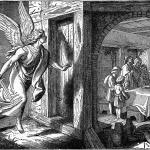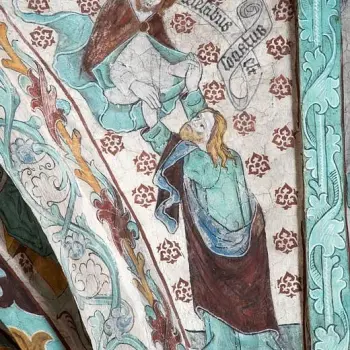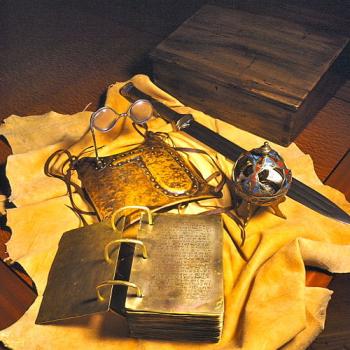Continuing with details and other stories from other perspectives parallel to the Biblical narrative, I pulled this interesting conglomeration of information from the Jewish Encyclopedia about Moses‘ life up until the time he approached Pharoah to let God’s people go. I left the source information inserted if you’d like to read the stories from the source materials. Stories of Moses
Moses is Judaism’s most important prophet and many mythical legends persist about his life. So it seems like a great time to add a reminder about the Lord’s stance on apocryphal writings.
Verily, thus saith the Lord unto you concerning the —There are many things contained therein that are true, and it is mostly translated correctly;
There are many things contained therein that are not true, which are by the hands of men. . . .
Therefore, whoso readeth it, let him , for the Spirit manifesteth truth;
And whoso is enlightened by the shall obtain benefit therefrom;
And whoso receiveth not by the Spirit, cannot be benefited. . . .
Stories of Moses from the Jewish Encylopedia
The Beginnings.
The birth of Moses as the liberator of the people of Israel was foretold to Pharaoh by his soothsayers, in consequence of which he issued the cruel command to cast all the male children into the river (Ex. i. 22). Later on Miriam also foretold to her father, Amram, that a son would be born to him who would liberate Israel from the yoke of Egypt (Soṭah 11b, 12a; Meg. 14a; Ex. R. i. 24; “S. Y.,” Shemot, pp. 111a, 112b; comp. Josephus, “Ant.” ii. 9, § 3). Moses was born on Adar 7 (Meg. 13b) in the year 2377 after the creation of the world (Book of Jubilees, xlvii. 1). … A peculiar and glorious light filled the entire house at his birth (ib.; “S. Y.” p. 112b), indicating that he was worthy of the gift of prophecy (Soṭah l.c.). He spoke with his father and mother on the day of his birth, and prophesied at the age of three (Midr. Peṭirat Mosheh, in Jellinek, “B. H.” i. 128).
His mother kept his birth secret for three months, when Pharaoh was informed that she had borne a son. The mother put the child into a casket, which she hid among the reeds of the sea before the king’s officers came to her (Jubilees, l.c. 47; “D. Y.” in Jellinek, “B. H.” ii. 3; “S. Y.” p. 112b). For seven days his mother went to him at night to nurse him, his sister Miriam protecting him from the birds by day (Jubilees, l.c. 4).
Pharaoh’s Daughter.
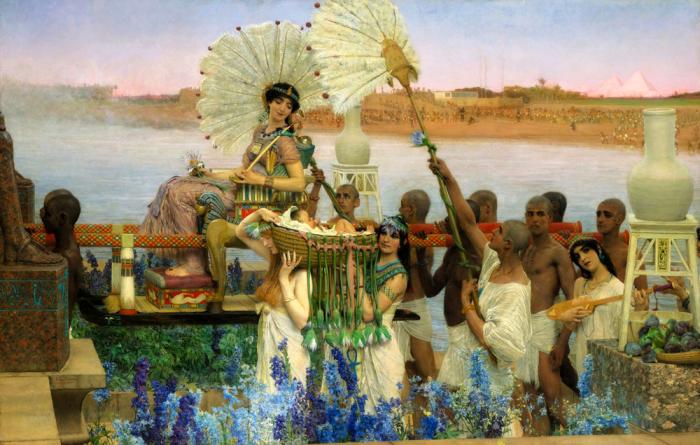
Then God sent a fierce heat upon Egypt (“D. Y.” l.c.), and Pharaoh’s daughter Bithiah (comp. I. Chron. iv. 18; Tarmut [Thermutis], according to Josephus, l.c. and Jubilees, l.c.), who was afflicted with leprosy, went to bathe in the river. Hearing a child cry, she beheld a casket in the reeds. She caused it to be brought to her, and on touching it was cured of her leprosy (Ex. R. i. 27). For this reason she was kindly disposed toward the child. When she opened the casket she was astonished at his beauty (Philo, “Vita Mosis,” ii.), and saw the Shekinah with him (Ex. R. i. 28). Noticing that the child was circumcised, she knew that the parents must have been Hebrews (Soṭah 12b).
Gabriel struck Moses, so as to make him cry and arouse the pity of the princess (Ex. R. i. 28). She wished to save the child; but as her maids told her she must not transgress her father’s commands, she set him down again (Midr. Abkir, in Yalḳ., Ex. 166). Then Gabriel threw all her maids down (Soṭah 12b; Ex. R. i. 27); and God filled Bithiah with compassion (Yalḳ., l.c.), and caused the child to find favor in her eyes (“M. W.” in Jellinek, l.c. i. 41). Thereupon she took the child up, saved him, and loved him much (Ex. R. l.c.). This was on the sixth day of the month of Siwan (Soṭah 12b); according to another version, on Nisan 21 (ib.).
When the soothsayers told Pharaoh that the redeemer of Israel had been born and thrown into the water, the cruel edict ordering that the children be thrown into the river was repealed (Ex. R. i. 29; Soṭah l.c.). Thus the casting away of Moses saved Israel from further persecution. According to another version (Gen. R. xcvii. 5),600,000 children had already been thrown into the river, but all were saved because of Moses.
His Bringing up.
Bithiah, Pharaoh’s daughter, took up the child to nurse him; but he refused the breast (“M. W.” l.c.). Then she gave him to other Egyptian women to nurse, but he refused to take nourishment from any of them (Josephus, l.c. ii. 9, § 5; “S. Y.” p. 112b; Soṭah 12b; “D. Y.” p. 3). The mouth which was destined to speak with God might not take unclean milk (Soṭah l.c.; “D. Y.” l.c.); Bithiah therefore gave him to his mother to nurse. Another legend says that he did not take any milk from the breast (Yalḳ., Wayelek, 940). Bithiah then adopted him as her son (“S. Y.” p. 113b).
Aside from the name “Moses,” which Bithiah gave to him (Ex. ii. 10), he had seven (Lev. R. i. 3), or according to other stories ten, other names given to him by his mother, his father, his brother Aaron, his sister Miriam, his nurse, his grandfather Kehat, and Israel (“D. Y.” p. 3; “S. Y.” p. 112b; Meg. 13a). These names were: Jared, Abi Gedor, Ḥeber, Abi Soko, Jekuthiel, Abi Zanoah, and Shemaiah (“Shama ‘Yah” = “God has heard”), the last one being given to him by Israel. He was also called “Heman” ([i.e.,  ; Num. xii. 7] B. B. 15a).
; Num. xii. 7] B. B. 15a).
Removes Pharaoh’s Crown.
Moses was a very large child at the age of three (Ex. R. i. 32; comp. Josephus; l.c.; Philo, l.c.); and it was at this time that, sitting at the king’s table in the presence of several princes and counselors, he took the crown from Pharaoh’s head and placed it on his own (“D. Y.” l.c.; for another version see “M. W.” l.c.). The princes were horrified at the boy’s act; and the soothsayer said that this was the same boy who, in accordance with their former predictions, would destroy the kingdom of Pharaoh and liberate Israel (Josephus, l.c.; “M. W.” l.c.).
Balaam and Jethro were at that time also among the king’s counselors (Soṭah 11a; Sanh. 106). Balaam advised the king to kill the boy at once; but Jethro (according to “D. Y.” l.c., it was Gabriel in the guise of one of the king’s counselors) said that the boy should first be examined, to see whether he had sense enough to have done such an act intentionally. All agreed with this advice. A shining piece of gold, or a precious stone, together with a live coal, was placed on a plate before the boy, to see which of the two he would choose. The angel Gabriel then guided his hand to the coal, which he took up and put into his mouth. This burned his tongue, causing him to stutter (comp. Ex. iv. 10); but it saved his life (“M. W.” l.c.; “D. Y.” l.c.; “S. Y.” l.c.; Ex. R. i. 31).
Moses remained in Pharaoh’s house fifteen years longer (“D. Y.” l.c.; “M. W.” l.c.). According to the Book of Jubilees (l.c.), he learned the writing of the Assyrians (the “Ketab Ashurit”; the square script ?) from his father, Amram. During his sojourn in the king’s palace he often went to his brethren, the slaves of Pharaoh, sharing their sad lot. He helped any one who bore a too heavy burden or was too weak for his work. He reminded Pharaoh that a slave was entitled to some rest, and begged him to grant the Israelites one free day in the week. Pharaoh acceded to this request, and Moses accordingly instituted the seventh day, the Sabbath, as a day of rest for the Israelites (Ex. R. i. 32; “S. Y.” p. 115a).
Flees from Egypt.
Moses did not commit murder in killing the Egyptian (Ex. ii. 12); for the latter merited death because he had forced an Israelitish woman to commit adultery with him (Ex. R. i. 33). Moses was at that time eighteen years of age (“D. Y.” l.c.; “M. W.” l.c.; “S. Y.” l.c.). According to another version, Moses was then twenty, or possibly forty, years of age (Ex. R. i. 32, 35). These divergent opinions regarding his age at the time when he killed the Egyptian are based upon different estimates of the length of his stay in the royal palace (Yalḳ., Shemot, 167; Gen. R. xi.), both of them assuming that he fled from Egypt immediately after the slaying (Ex. ii. 15). Dathan and Abiram were bitter enemies of Moses, insulting him and saying he should not act as if he were a member of the royal house, since he was the son not of Batya, but of Jochebed. Previous to this they had slandered him before Pharaoh.
Pharaoh had forgiven Moses everything else, but would not forgive him for killing the Egyptian. He delivered him to the executioner, who chose a very sharp sword with which to kill Moses; but the latter’s neck became like a marble pillar, dulling the edge of the sword (“M. W.” l.c.). Meanwhile the angel Michael descended from heaven, and took the form of the executioner, giving the latter the shape of Moses and so killing him. He then took up Moses and carried him beyond the frontier of Egypt for a distance of three, or, according to another account, of forty, days (“D. Y.” l.c.; “S. Y.” p. 115b). According to another legend, the angel took the shape of Moses, and allowed himself to be caught, thus giving the real Moses an opportunity to escape (Mek., Yitro. 1 [ed. Weiss. 66a]; Ex. R. i. 36).
King in Ethiopia.
The fugitive Moses went to the camp of King Nikanos, or Kikanos, of Ethiopia, who was at that time besieging his own capital, which had been traitorously seized by Balaam and his sons and made impregnable by them through magic. Moses joined the army of Nikanos, and the king and all his generals took a fancy to him, because he was courageous as a lion and his face gleamed like the sun (“S. Y.” P. 116a; comp. B. B. 75a).
When Moses had spent nine years with the army King Nikanos died, and the Hebrew was made general. He took the city, driving out Balaam and his sons Jannes and Jambres, and was proclaimed king by the Ethiopians. He was obliged, in deference to the wishes of the people, to marry Nikanos’ widow, Adoniya (comp. Num. xii.), with whom he did not, however, cohabit (“D. Y.” l.c.; “S. Y.” p. 116b). Miriam and Aaron spoke against Moses on account of the Cushite (Ethiopian) woman whom he had married. He was twenty-seven years of age when he became king; and he ruled over Ethiopia for forty years, during which he considerably increased the power of the country.
After forty years his wife, Queen Adoniya, accused him before the princes and generals of not having cohabited with her during the many years of their marriage, and of never having worshiped the Ethiopian gods. She called upon the princes not to suffer a stranger among them as king, but to make her son by Nikanos, Munahas or Munakaros, king. The princes complied with her wishes, but dismissed Moses in peace, giving him great treasures. Moses, who was at this time sixty-seven years old, went from Ethiopia to Midian (ib.).
According to Josephus’ account of this story (see Moses in Hellenistic Literature), after Moses’ marriage to the daughter of the Ethiopian king, he did not become King of Ethiopia, but led his troops back to Egypt, where he remained. The Egyptians and even Pharaoh himself were envious of his glorious deeds, fearing also that he might use his power to gain dominion over Egypt. They therefore sought how they might assassinate him; and Moses, learning of the plot, fled to Midian.
This narrative of Josephus’ agrees with two haggadic accounts, according to which Moses fled from Egypt direct to Midian, not staying in Ethiopia at all. These accounts are as follows: (1) Moses lived for twenty years in Pharaoh’s house; he then went to Midian, where he remained for sixty years, when, as a man of eighty, he undertook the mission of liberating Israel (Yalḳ., Shemot, 167). (2) Moses lived for forty years in Pharaoh’s house; thence he went to Midian, where he stayed for forty years until his mission was entrusted to him (Gen. R. xi.; comp. Sifre, Deut. xxxiv. 7).
Relations with Jethro.
On his arrival at Midian Moses told his whole story to Jethro, who recognized him as the man destined to destroy the Egyptians. He therefore took Moses prisoner in order to deliver him to Pharaoh (“D. Y.” l.c.). According to another legend, Jethro took him for an Ethiopian fugitive, and intended to deliver him to the Ethiopians (“S. Y.” l.c.). He kept him prisoner for seven (“D. Y.” l.c.) or ten (“S. Y.” l.c.) years. Both of these legends are based on another legend according to which Moses was seventy-seven years of age when Jethro liberated him.
According to the legend (“D. Y.” l.c.) which says that he went to Nikanos’ camp at the age of thirty, and ruled over Ethiopia for forty years, he was only seven years in Jethro’s hands (30+40+7 = 77). According to the other legend (“S. Y.” l.c.) he was eighteen years old when he fled from Egypt; he remained for nine years in the camp of Nikanos; and was king over Ethiopia for forty years. Hence he must have been Jethro’s captive for ten years, or till his seventy-seventh year.
The Circumcision of Gershom.
Moses was imprisoned in a deep dungeon in Jethro’s house, and received as food only small portions of bread and water. He would have died of hunger had not Zipporah, to whom Moses had before his captivity made an offer of marriage by the well, devised a plan by which she no longer went out to pasture the sheep, but remained at home to attend to the household, being thereby enabled to supply Moses with food without her father’s knowledge. After ten (or seven) years Zipporah reminded her father that he had at one time cast a man into the dungeon, who must have died long ago; but if he were still living he must be a just man whom God had kept alive by a miracle. Jethro went to the dungeon and called Moses, who answered immediately. As Jethro found Moses praying, he really believed that he had been saved by a miracle, and liberated him.
Jethro had planted in his garden a marvelous rod, which had been created on the sixth day of the Creation, on Friday afternoon, and had been given to Adam. This curious rod had been handed down through Enoch, Shem, Abraham, Isaac, and Jacob to Joseph, at whose death it came into the possession of Pharaoh’s court. Jethro, who saw it there, stole it and planted it in his garden. On the rod were engraved the name of God (Yhwh) and the initials of the ten plagues destined for Egypt.
Jethro asked every one who wished to marry one of his daughters to pull up the rod; but no suitor had yet succeeded in doing so. Moses, on being set at liberty, walked in the garden, saw the rod, and read the inscription. He easily pulled it out of the ground and used it for a staff (see Aaron’s Rod). Jethro thereby recognized Moses as the deliverer of Israel, and gave him the virtuous Zipporah as wife, together with much money (“S. Y.,” “D. Y.,” and “M. W.” l.c.).
Jethro stipulated that the first-born son of the marriage should adopt Jethro’s pagan belief, while all the other children might be reared as Jews; and Moses agreed thereto (Mek., Yitro, 1 [ed. Weiss, p. 65b]). According to “M. W.” l.c., one-half of the children of this marriage were to belong to Judaism and one-half to paganism. When therefore his son Gershom—who subsequently became the father of Jonathan—was born, Moses, under his agreement with Jethro, could not circumcise him (“S. Y.” l.c.).
Moses, therefore, went with his wife and child (another version says that both of his sons were then already born) to Egypt. On the way he met Satan, or Mastema, as he is called in the Book of Jubilees (xlviii. 2), in the guise of a serpent, which proceeded to swallow Moses, and had ingested the upper part of his body, when he stopped. Zipporah seeing this, concluded that the serpent’s action was due to the fact that her son had not been circumcised (Ned. 31b-32a; Ex. R. v.), whereupon she circumcised him and smeared some of the blood on Moses’ feet. A voice (“bat ḳol”) was then heard commanding the serpent to disgorge the half-swallowed Moses, which it immediately did. When Moses came into Egypt he met his old enemies Dathan and Abiram, and when they asked him what he was seeking in Egypt, he immediately returned to Midian (“M. W.” l.c.).
At the Burning Bush.
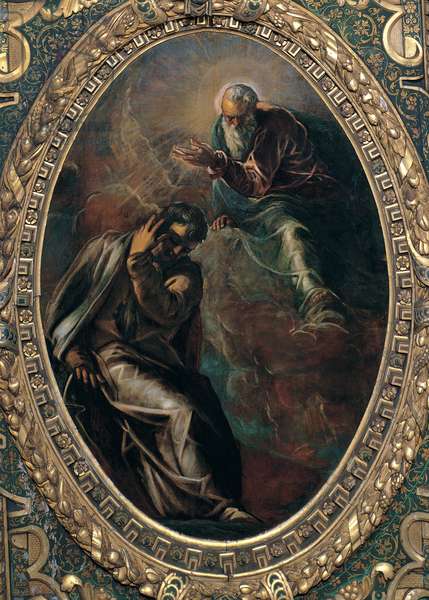
As the shepherd of his father-in-law he drove his sheep far into the desert (Ex. iii. 1), in order to prevent the sheep from grazing in fields not belonging to Jethro (Ex. R. i. 3). Here God appeared to him and addressed him for seven consecutive days (ib. iii. 20). Moses, however, refused to listen, because he would not allow himself to be disturbed in the work for which he was paid.
Then God caused the flaming bush to appear (Ex. iii. 2-3), in order to divert Moses’ attention from his work. The under-shepherds with Moses saw nothing of the marvelous spectacle, which Moses alone beheld (Ex. R. ii. 8). Moses then interrupted his work, and stepped nearer the bush to investigate (ib. ii. 11). As Moses was at this time entirely inexperienced in prophecy, God, in calling him, imitated the voice of Amram, so as not to frighten him. Moses, who thought that his father, Amram, was appearing to him, said: “What does my father wish?” God answered: “I am the God of thy father” (Ex. iii. 6), and gave him the mission to save Israel (ib.).
Moses hesitated to accept the mission (comp. Ex. iii. 11) chiefly because he feared that his elder brother, Aaron, who until then had been the only prophet in Israel, might feel slighted if his younger brother became the savior of the people; whereupon God assured him that Aaron would be glad of it (Ex. R. iii. 21-22).
According to another version (ib. xv. 15), Moses said to God: “Thou hast promised Jacob that Thou Thyself wouldest liberate Israel [comp. Gen. xlvi. 4], not appointing a mediator.” God answered: “I myself will save them; but go thou first and announce to My children that I will do so.” Moses consented, and went to his father-in-law, Jethro (Ex. iv. 18), to obtain permission to leave Midian (Ned. 65a; Ex. R. iv. 1-4), for he had promised not to leave Midian without his sanction. Moses departed with his wife and children, and met Aaron (comp. Ex. iv. 27), who told him it was not right to take them into Egypt, since the attempt was being made to lead the Israelites out of that country. He therefore sent his wife and children back to Midian (“S. Y.” p. 123a; Mek., Yitro, 1 [ed. Weiss, p. 65b]).
When they went to Pharaoh, Moses went ahead, Aaron following, because Moses was more highly regarded in Egypt (Ex. R. ix. 3); otherwise Aaron and Moses were equally prominent and respected (Mek., Bo, 1 [ed. Weiss, p. 1a]). At the entrance to the Egyptian royal palace were two leopards, which would not allow any one to approach unless their guards quieted them; but when Moses came they played with him and fawned upon him as if they were his dogs (“D. Y.” l.c.; “S. Y.” l.c.). According to another version, there were guards at every entrance. Gabriel, however, introduced Moses and Aaron into the interior of the palace without being seen (Yalḳ., Shemot, 175). As Moses’ appearance before Pharaoh resulted only in increasing the tasks of the children of Israel (comp. Ex. v.), Moses returned to Midian; and, according to one version, he took his wife and children back at the same time (Ex. R. v. 23).



